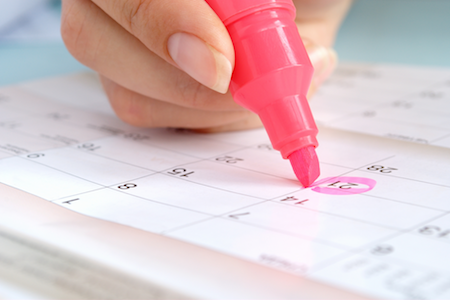
When's your period? How to track yours with Ovia, and how we predict when it will come next
After ovulation, your levels of the hormone progesterone spike. This hormone thickens the lining of the uterus in preparation for a fertilized egg. When your body recognizes that there is no fertilized egg, progesterone levels fall which causes the uterine lining to shed. This is what you see when you get your period. Read on to learn how period tracking works in Ovia.
What is a period?
Your period is the flow of blood and tissue that marks both the beginning and the end of a menstrual cycle. If no egg is fertilized during ovulation, you'll get a period approximately two weeks afterward. This marks the beginning of a new cycle and provides another opportunity for an egg cell to meet a friendly, healthy sperm cell. Menstruation is triggered by the lack of the hormone progesterone, which spikes after ovulation to prepare the uterus for pregnancy but decreases once again if no fertilization occurs.
How long between periods?
The average time between cycles is 29 days and the average menstruation lasts between 3 and 7 days. These averages can deviate greatly from person to person. Even the same female may have fluctuations in her own cycle over time. In addition, those with irregular periods may notice a varying time span between periods, which can make it more difficult to accurately track ovulation.
Why does tracking my period help determine when I'm fertile?
Individuals who have predictable cycles can use their menstrual dates to better pinpoint when they'll ovulate. If you're tracking your period, you'll be able to identify trends in your cycle that correlate with ovulation. Although it's more difficult to estimate when your fertile window will occur if you have an irregular period, Ovia is still able to predict it as long as you're regularly tracking your periods. Tracking one’s period can be incredibly helpful in best determining fertility and ovulation.
How does period tracking work in Ovia?
If you’re a new Ovia user, the app automatically projects the dates and duration of your next periods based on the information you provide at signup about the average length of your period and how regular or irregular your cycle is. If you’re an existing user, Ovia enhances these projections with the daily data you enter, including trends and averages of your past periods.
Ovia makes a distinction on your fertility calendar between period data that you’ve actually logged (the red droplets) and period data that Ovia projected for you (the gray droplets). Look for the gray droplet icons to learn when you can expect your monthly visitor. Ovia projects your upcoming periods over the next 2-3 months, depending on your cycle length.
My predicted period dates are wrong. How do I fix this?
Ovia is powerful, but there’s no way to get every period exactly right, every time, for every person. Small shifts are normal, even in the same person’s menstrual cycle. Logging your actual period data each day is the best way to adjust Ovia's calculations.
To fix an incorrectly predicted period (where Ovia thought you had your period, but you didn't), follow these steps:
- Go to the predicted period in the fertility calendar (you'll see it as gray droplets)
- Tap a day where Ovia predicted you had your period
- On the data logging screen, tap "no period" and save to remove the period
- Repeat step 3 for all incorrectly predicted days
- Enter your correct period days and Ovia will adjust its predictions to be more accurate next time
If Ovia correctly predicted your upcoming period on a particular day, tap that day in your calendar and confirm that you got your period to turn the droplet symbol from gray (projected) to red (actual).




